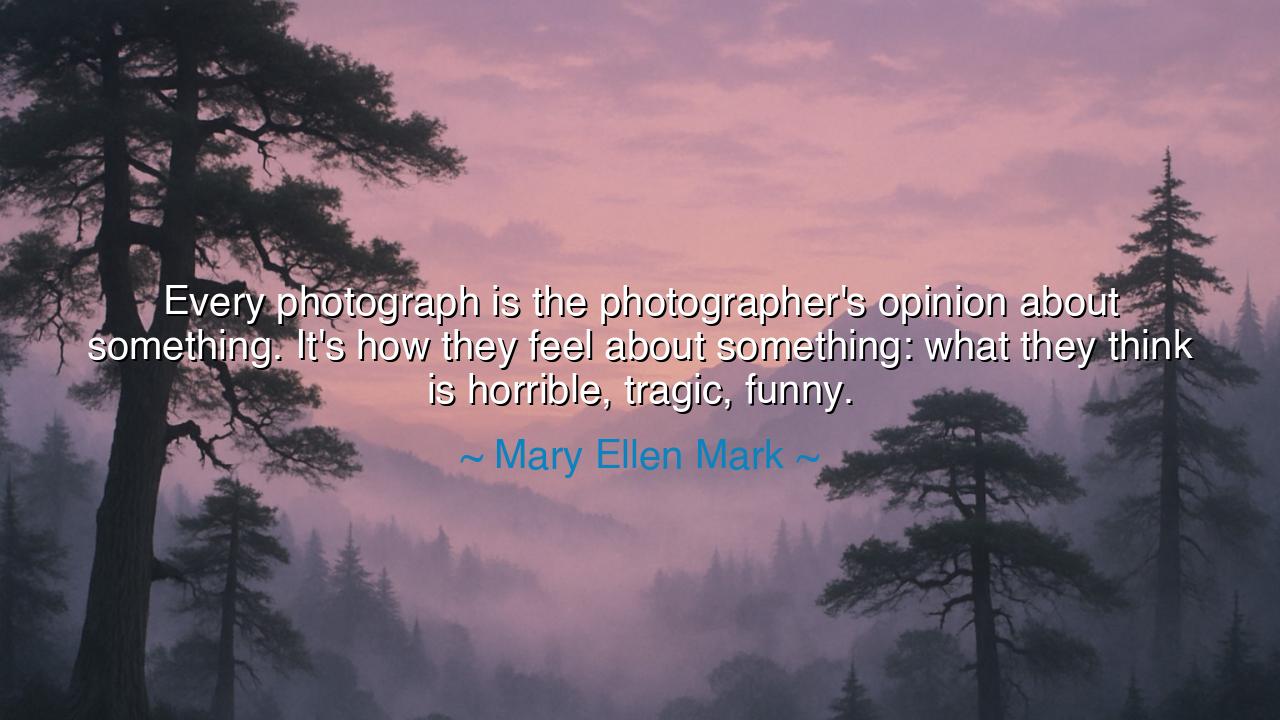
Every photograph is the photographer's opinion about something.
Every photograph is the photographer's opinion about something. It's how they feel about something: what they think is horrible, tragic, funny.






In the words of Mary Ellen Mark, “Every photograph is the photographer’s opinion about something. It’s how they feel about something: what they think is horrible, tragic, funny.” — there breathes a truth as ancient as art itself. For even though the camera may seem to capture life as it is, no image is ever truly neutral. Every picture is a mirror held up not only to the world, but to the soul of the one who took it. Through her words, Mark reminds us that the lens does not simply record — it reveals. What it reveals, however, is not merely light or shadow, but the vision, the emotion, and the moral stance of the one who stands behind it.
The meaning of her insight lies in understanding that art is never passive. To take a photograph is to make a choice — what to include, what to exclude, where to stand, what moment to freeze in time. Every decision, conscious or not, reflects the artist’s judgment, their values, and their heart. When Mark says that each photograph is an “opinion,” she speaks not of arrogance but of responsibility. The photographer is not merely a witness to the world’s events, but a participant in shaping how others will see them. A single image can stir compassion or condemnation, laughter or grief. Thus, the photograph becomes a moral statement, a piece of the artist’s soul embedded in silver, light, and time.
In the age of the ancients, there were no cameras — yet this truth was already known. The sculptor who carved the gods of marble, the poet who sang of heroes, the historian who inked the deeds of kings — all were expressing opinion, not mere record. When Phidias sculpted Zeus, he did not merely reproduce the form of a man — he expressed his belief in divinity, power, and mercy. So too does the modern photographer, through light instead of chisel, shape the divine or the dreadful according to the vision of their heart. The tools change; the intention remains eternal.
Consider the work of Dorothea Lange, whose haunting photograph Migrant Mother captured the face of the Great Depression. That image did not simply show poverty — it interpreted it. Lange’s camera wept with the mother’s eyes; her heart was present in every grain of that film. Through her empathy, she turned despair into dignity, sorrow into strength. She did not stand apart from her subject, but stood with her. And through that act, she transformed photography from documentation into truth. Mary Ellen Mark herself would later walk this same path — photographing street children, the forgotten, the misfits — not as curiosities, but as fellow souls. Her “opinions” were not words, but light made compassionate.
The origin of this wisdom comes from the heart of Mark’s own craft. Having lived among her subjects — from circuses in India to psychiatric wards in America — she understood that the act of seeing is sacred. To see truly is to care. To photograph, then, is to declare what matters, to assert: This, here, deserves to be remembered. Even what we find “horrible, tragic, or funny” is filtered through the lens of human feeling. Thus, every image becomes a reflection of both the world and the heart of the beholder. The camera, though mechanical, becomes a vessel for empathy or judgment, depending on the hand that holds it.
The lesson for us all — artists or not — is clear: no act of seeing is neutral. Whether through a camera, through conversation, or through the choices we make each day, we are always expressing our inner vision of the world. Therefore, we must cultivate awareness — to look not only at what we see, but at how we see it. What moves us? What repels us? What do we find tragic, or comic, or beautiful? In answering these questions, we uncover the essence of our humanity. The great photographers — like the great thinkers and poets — remind us that perception is creation. What we choose to see shapes who we become.
So, my friends, when you lift your gaze to the world — whether through a camera or through the eyes of your heart — remember the wisdom of Mary Ellen Mark. Do not seek to capture life as others tell you it is; capture it as you feel it. Let your vision be honest, even when it is uncomfortable. Let your “opinion” be born not of vanity, but of truth. For it is through such sincerity that art ceases to be decoration and becomes revelation. Every image, every word, every act of seeing becomes a testament to the soul’s encounter with reality.
And thus, her quote becomes more than a reflection on photography — it becomes a teaching for life itself. We are all, in some way, photographers of existence, framing moments, shaping meaning, revealing our hearts through what we notice and what we ignore. Let your eyes, then, be instruments of compassion. Let your seeing be deliberate, your opinions humane. For one day, when others look upon the images of your life — not the photos, but the choices — may they see, as in Mark’s own work, not just what was before you, but the depth of your human spirit behind the lens.






AAdministratorAdministrator
Welcome, honored guests. Please leave a comment, we will respond soon